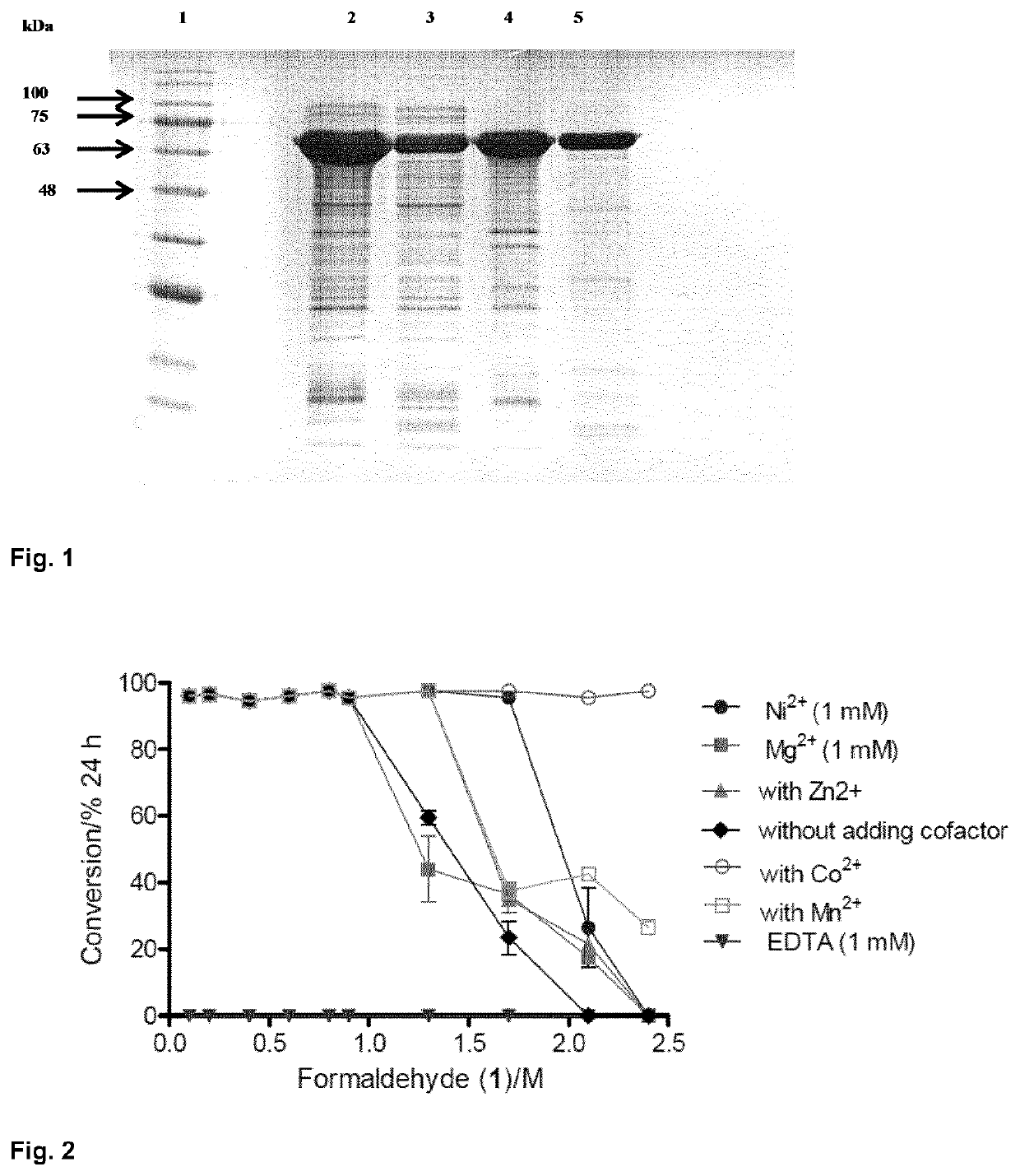Fusion proteins comprising an aldolase enzyme joined to a maltose binding protein
a technology of aldolase and maltose, which is applied in the field of enzymatic catalysis of aldol reactions, can solve the problems of reducing the biocatalytic efficiency far from industrial requests, high productivities, and inability to accept small open-chain aldehydes such as glyceraldehyde, aliphatic, aromatic aldehyde, etc., and achieves high substrate loading
- Summary
- Abstract
- Description
- Claims
- Application Information
AI Technical Summary
Benefits of technology
Problems solved by technology
Method used
Image
Examples
example 1
L-Homoserine Synthesis
[0151]A Two-step strategy using benzylamine as amine donor.
Step 1. Aldol Addition. Preparation of Sodium 4-hydroxy-2-oxobutanoate (I1)
[0152]
[0153]To a solution of MBP-YfaU Mg2+ (dialyzed against sodium phosphate buffer) (15.4 mg of protein, 2 mg mL-1) containing sodium pyruvate 2 (7.1 mL, 1.0 M at pH 6.5-7.0, adjusted with NaOH, 50 mM) in a Falcon tube, formaldehyde 1 (577 μL of commercial 12.3 M solution) was added step-wise (115.4 μL each 2 h), stirring in a vortex mixer (1000 rpm) at 25° C. After 16-24 h no pyruvate was detected by HPLC (>98% conversion) and the reaction was filtered through active charcoal (in a filter funnel Pyrex 3, 5 cm Ø, filter bed 1 cm) and the pellet was washed with water (3×10 mL). Solution was frozen at −80° C. and lyophilized to afford the title compound as a white solid (442 mg as mixture of ketone I1 and its hydrate form, 44% isolated yield).
[0154]When MBP-YfaU Mg2+ was dialyzed against sodium 3-(N-morpholino)propanesulfonate (M...
example 2
(±)-Sodium 4-hydroxytetrahydrofuran-2-carboxylate (α / β-I-2)
[0164]
[0165]Reaction was carried out in a Falcon Tube (15 mL). Sodium pyruvate (2) (0.65 g, 5.9 mmol) was dissolved in water (6 mL). Glycolaldehyde (8) (0.35 mg of the commercially available dimer corresponding to 5.9 mmol of monomer) was added to this solution and the pH was adjusted to 7.0 with NaOH (50 mM). The reaction was initiated by the addition of MBP-YfaU as lyophilized powder (30 mg). The mixture was left to react under orbital stirring (1000 rpm) at 25° C. for 16 h. The reaction conversion at this point was greater than 95%, as judged by HPLC analysis. Then, the reaction was centrifuged (5000 g at 4° C. for 30 minutes) and the enzyme in the supernatant, was removed using an Amicon ultrafiltration unit (Millipore, USA, MWCO 10 kDa, 5000 g at 4° C. for 60 minutes) and the residue washed with water (3×6 mL). The combined aqueous phase was frozen at −80° C. and lyophilized to afford the title compound as a white solid...
example 3
Sodium (4R,6S)-2,4-dihydroxy-6-methyltetrahydro-2H-pyran-2-carboxylate (13)
[0167]
Step 1. Synthesis (S)-3-hydroxybutanal (9)
[0168](S)-3-Hydroxybutanal (9) was obtained from (S)-4,4-dimethoxybutan-2-ol by acid hydrolysis as described below. (S)-4,4-Dimethoxybutan-2-ol was obtained from stereoselective reduction of 4,4-dimethoxybutan-2-one.
[0169](S)-4,4-Dimethoxybutan-2-ol (1.28 g, 9.5 mmol) was dissolved in water (10 mL) and Dowex® 50WX8 hydrogen form, 200-400 mesh, (2 g as dry powder) was added. The mixture was left to react under orbital stirring (1000 rpm). After 12 h, when most of the reactant was consumed as judged by TLC, the reaction was filtered and resin was washed with water (5 mL). The aldehyde 12 obtained was used in solution (0.5 M, 17 mL) without any further purification.
Step 2. Preparation of adduct I-3a
[0170]To a solution of (S)-3-hydroxybutanal (9) (11.2 mL, 5.6 mmol) sodium pyruvate (5.6 mL of 1.0 M sodium pyruvate solution in 50 mM sodium phosphate buffer pH 7.0) wa...
PUM
| Property | Measurement | Unit |
|---|---|---|
| molecular mass | aaaaa | aaaaa |
| pH | aaaaa | aaaaa |
| optical density | aaaaa | aaaaa |
Abstract
Description
Claims
Application Information
 Login to View More
Login to View More - R&D
- Intellectual Property
- Life Sciences
- Materials
- Tech Scout
- Unparalleled Data Quality
- Higher Quality Content
- 60% Fewer Hallucinations
Browse by: Latest US Patents, China's latest patents, Technical Efficacy Thesaurus, Application Domain, Technology Topic, Popular Technical Reports.
© 2025 PatSnap. All rights reserved.Legal|Privacy policy|Modern Slavery Act Transparency Statement|Sitemap|About US| Contact US: help@patsnap.com



